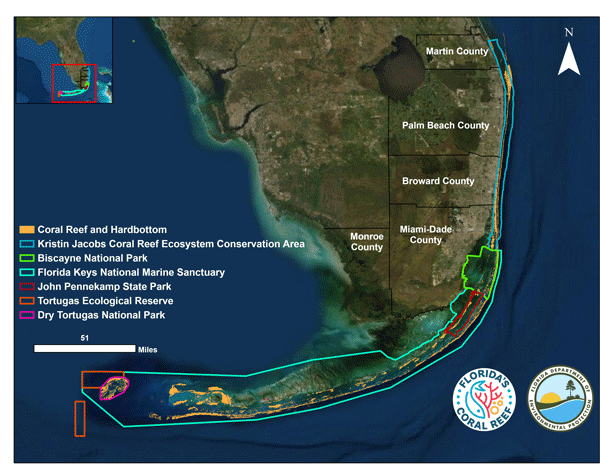
Florida Coral Reef Restoration and Conservation Area Purchases
This month, Governor Ron DeSantis awarded $9.5 million through Florida’s Coral Reef Restoration and Recovery Initiative to bolster academic and private partnerships to safeguard Florida’s Coral Reef, which extends more than 350 nautical miles from the Dry Tortugas to the St. Lucie Inlet. This funding will enhance coral recovery, including propagation and outplanting capacities critical to the health and longevity of Florida’s Coral Reef. Governor DeSantis and the Cabinet also approved an investment to protect nearly 28,000 acres of Florida’s natural lands and link existing conservation areas, marking the first acquisition within the Caloosahatchee-Big Cypress Corridor, an important Everglades and panther habitat.
Florida’s Coral Reef Restoration and Recovery Initiative ensures the state develops infrastructure and capacity for coral propagation, technology, skilled workforce, and logistics needed to support long-term recovery and restoration of Florida’s Coral Reef.
“As we tackle environmental challenges, we understand that preparation and planning make all the difference,” said Department of Environmental Protection Secretary Shawn Hamilton.
The Florida Department of Environmental Protection (DEP) and its partners are working to support the reef’s natural recovery processes through the large-scale cultivation, outplanting, and monitoring of coral colonies that are more resilient to environmental stressors. Other DEP programs are simultaneously working to address local coral challenges such as water quality restoration, including in Biscayne Bay.
Awardees will perform specific functions pertaining to their funding requests, including:
-
Expansion of land-based propagation infrastructure and capacity including the rearing of species most impacted by Stony Coral Tissue Loss Disease.
-
Expansion of research, in-water staging and development of propagation curriculum.
-
Expansion of coral restoration efforts, including off-shore grow-out nurseries.
-
Expansion of facilities to care for threatened coral species, such as Pillar Coral.
-
Expansion of yearly outplanting efforts.
As we see more and more developments being built in Florida, the preservation of land and the environment is crucial. Since 2019, the Florida Legislature has committed more than $1.25 billion to the Florida Forever Program, including $100 million in recurring annual funding. This has enabled the Florida Department of Environmental Protection (DEP) to acquire more than 220,000 acres for conservation, 90% of which are within the Florida Wildlife Corridor.
This month's land acquisition approvals:
The acquisition of 25,039 acres within the Caloosahatchee-Big Cypress Corridor in Collier and Hendry counties will further connect the Florida Panther National Wildlife Refuge and Big Cypress National Preserve to the Dinner Island Wildlife Management Area, Okaloacoochee Slough State Forest, and the Corkscrew Regional Ecosystem Wildlife and Environmental Area. Protection of these ecologically critical habitats and agricultural lands will prevent habitat fragmentation for a wide range of imperiled species, including the Florida panther. This property is within the Florida Wildlife Corridor.
The acquisition of 1,361 acres within the Yarborough Ranch Florida Forever Project in Seminole County will protect the Econlockhatchee River and Geneva Freshwater Lens, which provides drinking water for county residents. This property is surrounded by existing conservation land, thereby providing a critical linkage for a variety of imperiled species, including the Florida black bear. It will be managed by the Florida Forest Service as part of the Little Big Econ State Forest. This property is within the Florida Wildlife Corridor and, when it is acquired, this Florida Forever project will be complete.
The acquisition of 1,342 acres within the Lake Hatchineha Watershed Florida Forever Project in Polk County will expand public recreational opportunities and fill an important gap in the landscape between other state-owned conservation lands near Lake Hatchineha. This property is under direct threat of development and recently received local approvals to construct over 1,800 single-family homes as well as commercial development, but instead it will be managed by the Florida Fish and Wildlife Conservation Commission as a Wildlife Management Area. This property is within the Florida Wildlife Corridor.
The Governor and the Cabinet also approved the acquisition of permanent agricultural land conservation easements over more than 8,000 acres of working agricultural lands through the Florida Department of Agriculture and Consumer Services’ Rural and Family Lands Protection Program, including more than 3,000 acres within the Heart Bar Ranch, a working cattle ranch since 1847, two years after Florida achieved statehood, which is now operated by 5th and 6th generation family farmers.




